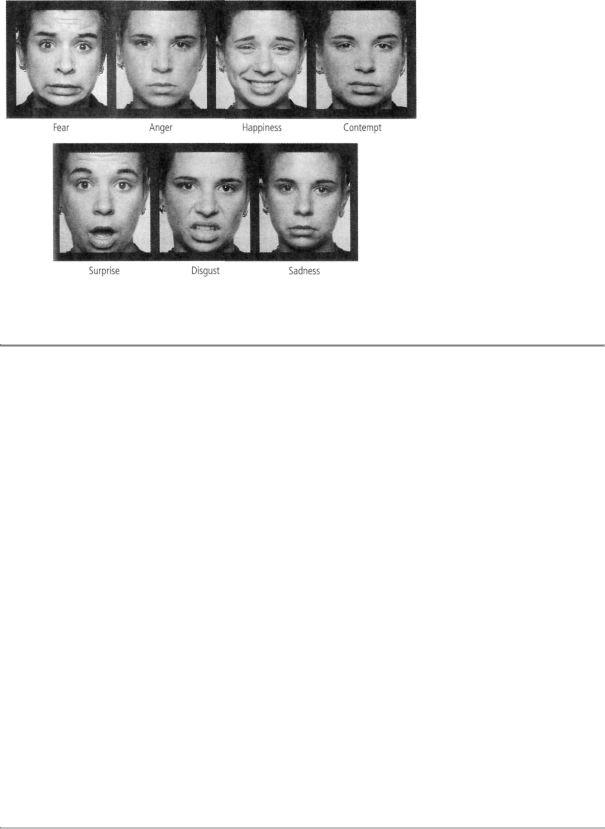
Erik_Kandel_-_V_poiskakh_pamyati_angl
.pdf
Until quite recently, there have been few biologically compelling ways to test psychodynamic ideas or to evaluate the efficacy of one therapeutic approach over another. A combination of effective shortterm psychotherapy and brain imaging may now give us just that—a way of revealing both mental dynamics and the workings of the living brain. In fact, if psychotherapeutic changes are maintained over time, it is reasonable to conclude that different forms of psychotherapy lead to different structural changes in the brain, just as other forms of learning do.
The idea of using brain imaging to evaluate the outcome of different forms of psychotherapy is not an impossible dream, as studies of
obsessive-compulsive disorder have shown. This disorder has long been thought to reflect a disturbance of the basal ganglia, a group of structures that lies deep in the brain and plays a key role in modulating behavior. One of the structures of the basal ganglia, the caudate nucleus, is the primary recipient of information coming from the cerebral cortex and other regions of the brain. Brain imaging has found that obsessive-compulsive disorder is associated with increased metabolism in the caudate nucleus. Lewis R. Baxter, Jr., and his colleagues at the University of California, Los Angeles have found that obsessive-compulsive disorder can be reversed by cognitive behavioral psychotherapy. It can also be reversed pharmacologically by inhibiting the reuptake of serotonin. Both the drugs and psychotherapy reverse the increased metabolism of the caudate nucleus.
Brain-imaging studies of patients with depression commonly reveal a decrease in activity in the dorsal side of the prefrontal cortex but an increase in activity in the ventral side. Again, both psychotherapy and drugs reverse these abnormalities. Had imaging been available in 1895, when Freud wrote "On a Scientific Psychology," he might well have directed psychoanalysis along very different lines, keeping it in close relationship with biology, as he outlined in this essay. In this sense, combining brain imaging with psychotherapy represents top-down investigation of mind and continues the scientific program Freud had originally envisioned.
As we have seen, short-term psychotherapy now comes in at least four different forms, and brain imaging may provide a scientific means of distinguishing among them. If so, it may reveal that all effective psychotherapies work through the same anatomical and molecular mechanisms. Alternatively, and more likely, imaging may show that psychotherapies achieve their goals through distinctly different mechanisms in the brain. Psychotherapies are also likely to have adverse side effects, as drugs do. Empirical testing of psychotherapies could help us maximize the safety and effectiveness of these important treatments, much as it does for drugs. It could also help predict the outcome of particular types of psychotherapy and would direct patients to the ones most appropriate for them.
THE COMBINATION OF SHORT-TERM PSYCHOTHERAPY AND BRAIN
imaging may at last allow psychoanalysis to make its own distinctive contribution to the new science of mind. And not a moment too soon. There is an enormous public health need for effective therapies in a variety of mild and moderately serious mental illnesses. Studies by Ronald Kessler at Harvard suggest that almost 50 percent of the general population have had a psychiatric problem at one point in their lives. In the past, many of these people were treated with drugs. Drugs have been an enormous boon to psychiatry, but they can have side effects. Moreover, drugs alone are often not effective. Many patients do better when some form of psychotherapy is combined with drugs, while a surprising number of patients do reasonably well with psychotherapy alone.
In her book An Unquiet Mind, Kay Jamison describes the benefits of both modes of treatment for even a serious illness—in her case, bipolar disorder. Lithium treatment for the disorder prevented her disastrous highs, kept her out of the hospital, saved her life by preventing her from committing suicide, and made long-term psychotherapy possible. "But, ineffably," she writes, "psychotherapy heals. It makes some sense of the confusion, reins in the terrifying thoughts and feelings, returns some control and hope and possibility of learning from it all. Pills cannot, do not, ease one back into reality."

What I find so fascinating about Jamison's insight is her view of psychotherapy as a learning experience that allows her to pull together the strands of her experiences—her life story. It is, of course, memory that weaves one's life into a coherent whole. As psychotherapy is subjected to more rigorous tests of effectiveness and more biological studies of its effects, we will be able to examine the workings of memory and mind. We will be able to explore, for example, various styles of thinking to see how they affect the way we feel about the world and how we behave in it.
A REDUCTIONIST APPROACH TO PSYCHOANALYSIS WILL ALSO ENABLE
us to reach a deeper understanding of human behavior. The most important steps in this direction have been those taken in studies of
child development, an area that excited the imagination of Ernst Kris. Freud's gifted daughter, Anna, studied the traumatic effects of family disruption during World War II and found the first compelling evidence of the importance of the bonding relationship between parent and offspring during times of stress. The effects of family disruption were studied further by the New York psychoanalyst René Spitz, who compared two groups of infants separated from their mothers. One group was raised in a foundling home and cared for by nurses, each of whom was responsible for seven infants; the other group was in a nursing home attached to a women's prison, where the infants were cared for daily for brief periods of time by their mothers. By the end of the first year, the motor and intellectual performance of the children in the orphanage had fallen far below that of the children in the prison nursing home: children in the orphanage were withdrawn and showed little curiosity or gaiety. These classic studies were published in The Psychoanalytic Study of the Child, a set of volumes edited by three of the originators of observational studies of children: Anna Freud, Heinz Hartmann, and Ernst Kris.
In a paradigm of how reductionism can enhance our understanding of psychological processes, Harry Harlow at the University of Wisconsin extended this work by developing an animal model of maternal deprivation. He found that when newborn monkeys were isolated for six months to one year and then returned to the company of other monkeys, they were physically healthy but behaviorally devastated. They crouched in a corner of their cages and rocked back and forth, like severely disturbed or autistic children. They did not interact with other monkeys, nor did they fight, play, or show any sexual interest. Isolation of an older animal for a comparable period was innocuous. Thus, in monkeys, as in humans, there is a critical period for social development.
Harlow next found that the syndrome could be partially reversed by giving the isolated monkey a surrogate mother, a cloth-covered wooden dummy. This surrogate elicited clinging behavior in the isolated monkey but was insufficient for the development of fully normal social behavior. Normal social development could only be rescued
if, in addition to a surrogate mother, the isolated animal had contact for a few hours each day with a normal infant monkey that spent the rest of the day in the monkey colony.
The work of Anna Freud, Spitz, and Harlow was expanded by John Bowlby who formulated the idea that the defenseless infant maintains a closeness to its caretaker by means of a system of emotive and behavioral response patterns that he called the "attachment system." Bowlby conceived of the attachment system as an inborn instinctual or motivational system, much like hunger or thirst, that organizes the memory processes of the infant and directs it to seek proximity to and communication with its mother. From an evolutionary point of view, the attachment system clearly enhances the infant's chances of survival by allowing its immature brain to use the parent's mature functions to organize its own life processes. The infant's attachment mechanism is mirrored in the parent's emotionally sensitive responses to the infant's signals. Parental responses serve both to amplify and reinforce an infant's positive emotional states and to attenuate the infant's negative emotional states. These repeated experiences become encoded in procedural memory as expectations that help the infant feel secure.
These several approaches to studies of child development are now being explored in genetically modified mice to gain an even deeper insight into the nature of parent-offspring interaction.

Other experimental means of exploring psychoanalytic ideas about the functions of mind are available today. There are, for example, ways of distinguishing procedural (implicit) mental processes that are reflected in our memory for perceptual and motor skills from two other types of unconscious mental processes: the dynamic unconscious, which represents our conflicts, sexual strivings, and repressed thoughts and actions, and the preconscious unconscious, which is concerned with organization and planning and has ready access to consciousness.
Biological approaches to psychoanalytic theory could, in principle, explore all three types of unconscious processes. One way of doing so—which I will explain in the next chapter—is to compare images of activity generated by unconscious and conscious perceptual states and to identify the regions of the brain recruited by each. Most aspects of
our cognitive processes are based on unconscious inferences, on processes that occur without our awareness. We see the world effortlessly and as a unified whole—the foreground of a landscape and the horizon beyond it—because visual perception, the binding of the various elements of the visual image with one another, occurs without our being aware of it. As a result, most students of the brain believe, as Freud did, that we are not conscious of most cognitive processes, only of the end result of those processes. A similar principle seems to apply to our conscious sense of free will.
Bringing biology to bear on psychoanalytic ideas is likely to invigorate the role of psychiatry in modern medicine and\to encourage empirically based psychoanalytic thought to join the forces that are shaping the modern science of mind. The goal of this merger is to join radical reductionism, which drives basic biology, with the humanistic effort to understand the human mind, which drives psychiatry and psychoanalysis. This, after all, is the ultimate goal of brain science: to link the physical and biological studies of the natural world and its living inhabitants with an understanding of the intimate textures of the human mind and human experience.
28
CONSCIOUSNESS
Psychoanalysis introduced us to the unconscious in its several forms. Like many scientists now working on the brain, I have long been intrigued by the biggest question about the brain: the nature of consciousness and how various unconscious psychological processes relate to conscious thought. When I first talked with Harry Grundfest about Freud's structural theory of mind—the ego, the id, and the superego—the central focus of my thinking was: How do conscious and unconscious processes differ in their representation in the brain? But only recently has the new science of mind developed the tools for exploring this question experimentally.
To develop productive insights into consciousness, the new science of mind first had to settle on a working definition of consciousness as a state of perceptual awareness, or selective attention writ large. At its core, consciousness in people, is an awareness of self, an awareness of being aware.
Consciousness thus refers to our ability not simply to experience pleasure and pain but to attend to and reflect upon those experiences, and to do so in the context of our immediate lives and our life history. Conscious attention allows us to shut out extraneous experiences and focus on the critical event that confronts us, be it pleas-

ure or pain, the blue of the sky, the cool northern light of a Vermeer painting, or the beauty and calm we experience at the seashore.
UNDERSTANDING CONSCIOUSNESS IS BY FAR THE MOST CHALLENGING
task confronting science. The truth of this assertion can best be seen in the career of Francis Crick, perhaps the most creative and influential biologist of the second half of the twentieth century. When Crick first entered biology, after World War II, two great questions were thought to be beyond the capacities of science to answer: What distinguishes the living from the nonliving world? And what is the biological nature of consciousness? Crick turned first to the easier problem, distinguishing animate from inanimate matter, and explored the nature of the gene. By 1953, after just two years of collaboration, he and Jim Watson had helped solve that mystery. As Watson later described in The Double Helix, "at lunch Francis winged into the Eagle [Pub] to tell everyone within hearing distance that we had found the secret of life." In the next two decades, Crick helped crack the genetic code: how DNA makes RNA and RNA makes protein.
In 1976, at age sixty, Crick turned to the remaining scientific mystery: the biological nature of consciousness. This he studied for the rest of his life in partnership with Christof Koch, a young computational neuroscientist. Crick brought his characteristic intelligence and optimism to bear on the question; moreover, he made consciousness a focus of the scientific community which had previously ignored it. But, despite almost thirty years of continuous effort, Crick was able to budge the problem only a modest distance. Indeed, some scientists and philosophers of mind continue to find consciousness so inscrutable that they fear it can never be explained in physical terms. How can a biological system, a biological machine, they ask, feel anything? Even more doubtful, how can it think about itself?
These questions are not new. They were first posed in Western thought during the fifth century b.c. by Hippocrates and by the philosopher Plato, the founder of the Academy in Athens. Hippocrates was the first physician to cast superstition aside, basing his thinking on clinical observations and arguing that all mental processes emanate
from the brain. Plato, who rejected observations and experiments, believed that the only reason we can think about ourselves and our mortal body is that we have a soul that is immaterial and immortal. The idea of an immortal soul was subsequently incorporated into Christian thought and elaborated upon by St. Thomas Aquinas in the thirteenth century. Aquinas and later religious thinkers held that the soul— the generator of consciousness—is not only distinct from the body, it is also of divine origin.
In the seventeenth century, René Descartes developed the idea that human beings have a dual nature: they have a body, which is made up of material substance, and a mind, which derives from the spiritual nature of the soul. The soul receives signals from the body and can influence its actions but is itself made up of an immaterial substance that is unique to human beings. Descartes' thinking gave rise to the view that actions like eating and walking, as well as sensory perception, appetites, passions, and even simple forms of learning, are all mediated by the brain and can be studied scientifically. Mind, however, is sacred and as such is not a proper subject of science.
It is remarkable to reflect that these seventeenth-century ideas were still current in the 1980s. Karl Popper, the Vienna-born philosopher of science, and John Eccles, the Nobel laureate neurobiologist, espoused dualism all of their lives. They agreed with Aquinas that the soul is immortal and independent of the brain. Gilbert Ryle, the British philosopher of science, referred to the notion of the soul as "the ghost in the machine."
TODAY, MOST PHILOSOPHERS OF MIND AGREE THAT WHAT WE
call consciousness derives from the physical brain, but some disagree with Crick as to whether it can ever be approached scientifically. A few, such as Colin McGinn, believe that consciousness simply cannot be studied, because the architecture of the brain poses limitations on human cognitive

capacities. In McGinn's view, the human mind may simply be incapable of solving certain problems. At the other extreme, philosophers such as Daniel Dennett deny that there is any problem at all. Dennett argues, much as neurologist John Hughlings Jackson did a century earlier, that consciousness is not a distinct opera-
tion of the brain; rather, it is the combined result of the computational workings of higher-order areas of the brain concerned with later stages of information processing.
Finally, philosophers such as John Searle and Thomas Nagel take a middle position, holding that consciousness is a discrete set of biological processes. The processes are accessible to analysis, but we have made little headway in understanding them because they are very complex and represent more than the sum of their parts. Consciousness is therefore much more complicated than any property of the brain that we understand.
Searle and Nagel ascribe two characteristics to the conscious state: unity and subjectivity. The unitary nature of consciousness refers to the fact that our experiences come to us as a unified whole. All of the various sensory modalities are melded into a single, coherent, conscious experience. Thus when I approach a rosebush in the botanical garden at Wave Hill near my house in Riverdale, I sniff the exquisite fragrance of the blossoms at the same time that I see their beautiful red color—and I perceive this rosebush against the background of the Hudson River and the cliffs of the Palisade mountain ridge behind it. My perception is not only whole during the moment I experience it, it is also whole two weeks later, when I engage in mental time travel to recapture the moment. Despite the fact that there are different organs for smell and vision, and that each uses its own individual pathways, they converge in the brain in such a way that my perceptions are unified.
The unitary nature of consciousness poses a difficult problem, but perhaps not an insurmountable one. This unitary nature can break down. In a surgical patient whose brain is severed between the two hemispheres, there are two conscious minds, each with its own unified percept.
Subjectivity, the second characteristic of conscious awareness, poses the more formidable scientific challenge. Each of us experiences a world of private and unique sensations that is much more real to us than the experiences of others. We experience our own ideas, moods, and sensations directly, whereas we can only appreciate another person's experience indirectly, by observing or hearing about it. We there-
fore can ask, Is your response to the blue you see and the jasmine you smell—the meaning it has for you—identical to my response to the blue I see and the jasmine I smell and the meaning these have for me?
The issue here is not one of perception per se. It is not whether we each see a very similar shade of the same blue. That is relatively easy to establish by recording from single nerve cells in the visual system of different individuals. The brain does reconstruct our perception of an object, but the object perceived—the color blue or middle on the piano—appears to correspond to the physical properties of the wavelength of the reflected light or the frequency of the emitted sound. Instead, the issue is the significance of that blue and that note for each of us. What we do not understand is how electrical activity in neurons gives rise to the meaning we ascribe to that color or that wavelength of sound. The fact that conscious experience is unique to each person raises the question of whether it is possible to determine objectively any characteristics of consciousness that are common to everyone. If the senses ultimately produce experiences that are completely and personally subjective, we cannot, the argument goes, arrive at a general definition of consciousness based on personal experience.
Nagel and Searle illustrate the difficulty of explaining the subjective nature of consciousness in physical terms as follows: Assume we succeed in recording the electrical activity of neurons in a region known to be important for consciousness while the person being studied carries out some task that requires conscious attention. For example, suppose we identified the cells that fire when I look at

and become aware of a red image of the blossoms on a rosebush at Wave Hill. We have now taken a first step in studying consciousness— namely, we have found what Crick and Koch have called the neural correlate of consciousness for this one percept. For most of us, this would be a great advance because it pinpoints a material concomitant of conscious perception. From there we could go on to carry out experiments to determine whether these correlates also meld into a coherent whole, that is, the background of the Hudson River and the Palisades. But for Nagel and Searle, this is the easy problem of con-
sciousness. The hard problem of consciousness is the second mystery, that of subjective experience.
How is it that I respond to the red image of a rose with a feeling that is distinctive to me? To use another example, what grounds do we have for believing that when a mother looks at her child, the firing of cells in the region of the cortex concerned with face recognition accounts for the emotions she feels and for her ability to summon the memory of those emotions and that image of her child?
As yet, we do not know how the firing of specific neurons leads to the subjective component of conscious perception, even in the simplest case. In fact, according to Searle and Nagel, we lack an adequate theory of how an objective phenomenon, such as electrical signals in the brain, can cause a subjective experience, such as pain. And because science as we currently practice it is a reductionist, analytical view of complicated events, while consciousness is irreducibly subjective, such a theory lies beyond our reach for now.
According to Nagel, science cannot take on consciousness without a significant change in methodology, a change that would enable scientists to identify and analyze the elements of subjective experience. Those elements are likely to be basic components of brain function, much as atoms and molecules are basic components of matter, but to exist in a form we cannot yet imagine. The reductions performed routinely in science are not problematic, Nagel holds. Biological science can readily explain how the properties of a particular type of matter arise from the objective properties of the molecules of which it is made. What science lacks are rules for explaining how subjective properties (consciousness) arise from the properties of objects (interconnected nerve cells).
Nagel argues that our complete lack of insight into the elements of subjective experience should not prevent us from discovering the neural correlates of consciousness and the rules that relate conscious phenomena to cellular processes in the brain. In fact, it is only by accumulating such information that we will be in a position to think about the reduction of something subjective to something physical and objective. But to arrive at a theory that supports this reduction,
we will first have to discover the elements of subjective consciousness. This discovery, says Nagel, will be enormous in its magnitude and its implications, requiring a revolution in biology and most likely a complete transformation of scientific thought.
The aim of most neural scientists working on consciousness is much more modest than this grand perspective would imply. They are not deliberately working toward or anticipating a revolution in scientific thought. Although they must struggle with the difficulties of defining conscious phenomena experimentally, they do not see those difficulties as precluding all experimental study under existing paradigms. Neural scientists believe, and Searle for one agrees with them, that they have been able to make considerable progress in understanding the neurobiology of perception and memory without having to account for individual experience. For example, cognitive neural scientists have made advances in understanding the neural basis of the perception of the color blue without addressing the question of how each of us responds to the same blue.

WHAT WE DO NOT UNDERSTAND IS THE HARD PROBLEM OF
consciousness—the mystery of how neural activity gives rise to subjective experience. Crick and Koch have argued that once we solve the easy problem of consciousness, the unity of consciousness, we will be able to manipulate those neural systems experimentally to solve the hard problem.
The unity of consciousness is a variant of the binding problem first identified in the study of visual perception. An intimate part of my experiencing the subjective pleasure of the moment at Wave Hill is how the look and the smell of roses in the gardens are bound together and unified with my view of the Hudson, the Palisades, and all the other component images of my perception. Each of these components of my subjective experience is mediated by different brain regions within my visual and olfactory and emotional systems. The unity of my conscious experience implies that the binding process must somehow connect and integrate all of these separate areas in the brain.
As a first step toward solving the easy problem of consciousness, we need to ask whether the unity of consciousness—a unity thought
to be achieved by neural systems that mediate selective attention—is localized in one or just a few sites, which would enable us to manipulate them biologically. The answer to this question is by no means clear. Gerald Edelman, a leading theoretician on the brain and consciousness, has argued effectively that the neural machinery for the unity of consciousness is likely to be widely distributed throughout the cortex and thalamus. As a result, Edelman asserts, it is unlikely that we will be able to find consciousness through a simple set of neural correlates. Crick and Koch, on the other hand, believe that the unity of consciousness will have direct neural correlates because they most likely involve a specific set of neurons with specific molecular or neuroanatomical signatures. The neural correlates, they argue, probably require only a small set of neurons acting as a searchlight: the spotlight of attention. The initial task, they argue, is to locate within the brain that small set of neurons whose activity correlates best with the unity of conscious experience and then to determine the neural circuits to which they belong.
How are we to find this small population of nerve cells that could mediate the unity of consciousness? What criteria must they meet? In Crick and Koch's last paper (which Crick was still correcting on his way to the hospital a few hours before he died, on July 28, 2004), they focused on the claustrum, a sheet of brain tissue that is located below the cerebral cortex, as the site that mediates unity of experience. Little is known about the claustrum except that it connects to and exchanges information with almost all of the sensory and motor regions of the cortex as well as the amygdala, which plays an important role in emotion. Crick and Koch compare the claustrum to the conductor of an orchestra. Indeed, the neuroanatomical connections of the claustrum meet the requirements of a conductor; it can bind together and coordinate the various brain regions necessary for the unity of conscious awareness.
The idea that obsessed Crick at the end of his life—that the claustrum is the spotlight of attention, the site that binds the various components of any percept together—is the last in a series of important ideas he advanced. Cricks enormous contributions to biology (the double helical structure of DNA, the nature of the genetic code, the
discovery of messenger RNA, the mechanisms of translating messenger RNA into the amino acid sequence of a protein, and the legitimizing of the biology of consciousness) put him in a class with Copernicus, Newton, Darwin, and Einstein. Yet his intense, lifelong focus on science, on the life of mind, is something he shares with many in the scientific community, and that obsession is symbolic of science at its best. The cognitive psychologist Vilayanur Ramachandran, a friend and colleague of Crick's, described Crick's focus on the claustrum during his last weeks:
Three weeks prior to his death I visited him in his home in La Jolla. He was eighty-eight, had terminal cancer, was in pain, and was on chemotherapy; yet he had obviously been working away nonstop on his latest project.

His very large desk—occupying half the room—was covered by articles, correspondence, envelopes, recent issues of Nature, a laptop (despite his dislike of computers), and recent books on neuroanatomy. During the whole two hours that I was there, there was no mention of his illness—only a flight of ideas on the neural basis of consciousness. He was especially interested in a tiny structure called the claustrum which, he felt, had been largely ignored by mainstream pundits. As I was leaving he said: "Rama, I think the secret of consciousness lies in the claustrum—don't you? Why else would this tiny structure be connected to so many areas in the brain?"— And gave me a sly, conspiratorial wink. It was the last time I saw him.
Since so little is known about the claustrum, Crick continued, he wanted to start an institute to focus on its function. In particular, he wanted to determine whether the claustrum is switched on when unconscious, subliminal perception of a given stimulus by a person's sensory organs turns into a conscious percept.
ONE EXAMPLE OF SUCH SWITCHING THAT INTRIGUED CRICK AND
Koch is binocular rivalry. Here, two different images—say, vertical
stripes and horizontal stripes—are presented to a person simultaneously in such a way that each eye sees only one set of stripes. The person may combine the two images and report seeing a plaid, but more commonly the person will see first one image, then the next, with horizontal and vertical stripes alternating back and forth spontaneously.
Using MRI, Eric Lumer and his colleagues at University College, London have identified the frontal and parietal areas of the cortex as the regions of the brain that become active when a person's conscious attention switches from one image to another. These two regions have a special role in focusing conscious attention on objects in space. In turn, the prefrontal and posterior parietal regions of the cortex seem to relay the decision regarding which image is to be enhanced to the visual system, which then brings the image into consciousness. Indeed, people with damage to the prefrontal cortex have difficulty switching from one image to the other in situations of binocular rivalry. Crick and Koch might argue that the frontal and parietal areas of the cortex are recruited by the claustrum, which switches attention from one eye to the other and unifies the image presented to conscious awareness by each eye.
As these arguments make clear, consciousness remains an enormous problem. But through the efforts of Edelman on the one hand, and Crick and Koch on the other, we now have two specific and testable theories worthy of exploration.
AS SOMEONE INTERESTED IN PSYCHOANALYSIS, I WANTED TO TAKE
the Crick-Koch paradigm of comparing unconscious and conscious perception of the same stimulus to the next step: determining how visual perception becomes endowed with emotion. Unlike simple visual perception, emotionally charged visual perception is likely to differ between individuals. Therefore, a further question is, How and where are unconscious emotional perceptions processed?
Amit Etkin, a bold and creative M.D.-Ph.D. student, and I undertook a study in collaboration with Joy Hirsch, a brain imager at Columbia, in which we induced conscious and unconscious perceptions of emotional stimuli. Our approach paralleled in the emotional
sphere that of Crick and Koch in the cognitive sphere. We explored how normal people respond consciously and unconsciously to pictures of people with a clearly neutral expression or an expression of fear on their faces. The pictures were provided by Peter Ekman at the University of California, San Francisco.
Ekman, who has cataloged more than 100,000 human expressions, was able to show, as did Charles Darwin before him, that irrespective of sex or culture, conscious perceptions of seven facial expressions—happiness, fear, disgust, contempt, anger, surprise, and sadness—have virtually the same meaning to everyone (figure 28-1). We therefore argued that fearful faces should elicit a similar response from the healthy young medical and

graduate student volunteers in our study, regardless of whether they perceived the stimulus consciously or unconsciously. We produced a conscious perception of fear by presenting the fearful faces for a long period, so people had time to reflect on them. We produced unconscious perception of fear by presenting the same faces so rapidly that the volunteers were unable to report which type of expression they had seen. Indeed, they were not even sure they had seen a face!
28-1 Ekman's seven universal facial expressions. (Courtesy of Paul Ekman.)
Since even normal people differ in their sensitivity to a threat, we gave all of the volunteers a questionnaire designed to measure background anxiety. In contrast to the momentary anxiety most people feel in a new situation, background anxiety reflects an enduring baseline trait.
Not surprisingly, when we showed the volunteers pictures of faces with fearful expressions, we found prominent activity in the amygdala, the structure deep in the brain that mediates fear. What was surprising was that conscious and unconscious stimuli affected different regions of the amygdala, and they did so to differing degrees in different people, depending on their baseline anxiety.
Unconscious perception of fearful faces activated the basolateral nucleus. In people, as in mice, this area of the amygdala receives most of the incoming sensory information and is the primary means by which the amygdala communicates with the cortex. Activation of the basolateral nucleus by unconscious perception of fearful faces occurred in direct proportion to a person's background anxiety: the higher the measure of background anxiety, the greater the person's response. People with low background anxiety had no response at all. Conscious perception of fearful faces, in contrast, activated the dorsal region of the amygdala, which contains the central nucleus, and it did so regardless of a person's background anxiety. The central nucleus of the amygdala sends information to regions of the brain that are part of the autonomic nervous system—concerned with arousal and defensive responses. In sum, unconsciously perceived threats disproportionately affect people with high background anxiety, whereas consciously perceived threats activate the fight-or-flight response in all volunteers.
We also found that unconscious and conscious perception of fearful faces activates different neural networks outside the amygdala. Here again, the networks activated by unconsciously perceived threats were recruited only by the anxious volunteers. Surprisingly, even unconscious perception recruits participation of regions within the cerebral cortex.
Thus viewing frightening stimuli activates two different brain systems, one that involves conscious, presumably top-down attention

and one that involves unconscious, bottom-up attention, or vigilance, much as a signal of salience does in explicit and implicit memory in Aplysia and in the mouse.
These are fascinating results. First, they show that in the realm of emotion, as in the realm of perception, a stimulus can be perceived both unconsciously and consciously. They also support Crick and Koch's idea that in perception, distinct areas of the brain are correlated with conscious and unconscious awareness of a stimulus. Second, these studies confirm biologically the importance of the psychoanalytic idea of unconscious emotion. They suggest that the effects of anxiety are exerted most dramatically in the brain when the stimulus is left to the imagination rather than when it is perceived consciously Once the image of a frightened face is confronted consciously even anxious people can accurately appraise whether it truly poses a threat.
A century after Freud suggested that psychopathology arises from conflict occurring on an unconscious level and that it can be regulated if the source of the conflict is confronted consciously, our imaging studies suggest ways in which such conflicting processes may be mediated in the brain. Moreover, the discovery of a correlation between volunteers' background anxiety and their unconscious neural processes validates biologically the Freudian idea that unconscious mental processes are part of the brain's system of information processing. While Freud's ideas have existed for more than one hundred years, no previous brain-imaging study had tried to account for how differences in people's behavior and interpretations of the world arise from differences in how they unconsciously process emotion. The finding that unconscious perception of fear lights up the basolateral nucleus of the amygdala in direct proportion to a person's baseline anxiety provides a biological marker for diagnosing an anxiety state and for evaluating the efficacy of various drugs and forms of psychotherapy.
In discerning a correlation between the activity of a neural circuit and the unconscious and conscious perception of a threat, we are beginning to delineate the neural correlate of an emotion—fear. That description might well lead us to a scientific explanation of con-
sciously perceived fear. It might give us an approximation of how neural events give rise to a mental event that enters our awareness. Thus, a half century after I left psychoanalysis for the biology of mind, the new biology of mind is getting ready to tackle some of the issues central to psychoanalysis and consciousness.
One such issue is the nature of free will. Given Freud's discovery of psychic determinism—the fact that much of our cognitive and affective life is unconscious—what is left for personal choice, for freedom of action?
A critical set of experiments on this question was carried out in 1983 by Benjamin Libet at the University of California, San Francisco. Libet used as his starting point a discovery made by the German neuroscientist Hans Kornhuber. In his study, Kornhuber asked volunteers to move their right index finger. He then measured this voluntary movement with a strain gauge while at the same time recording the electrical activity of the brain by means of an electrode on the skull. After hundreds of trials, Kornhuber found that, invariably, each movement was preceded by a little blip in the electrical record from the brain, a spark of free will! He called this potential in the brain the "readiness potential" and found that it occurred 1 second before the voluntary movement.
Libet followed up on Kornhuber's finding with an experiment in which he asked volunteers to lift a finger whenever they felt the urge to do so. He placed an electrode on a volunteer's skull and confirmed a readiness potential about 1 second before the person lifted his or her finger. He then compared the time it took for the person to will the movement with the time of the readiness potential. Amazingly, Libet found that the readiness potential appeared not after, but 200 milliseconds before a
